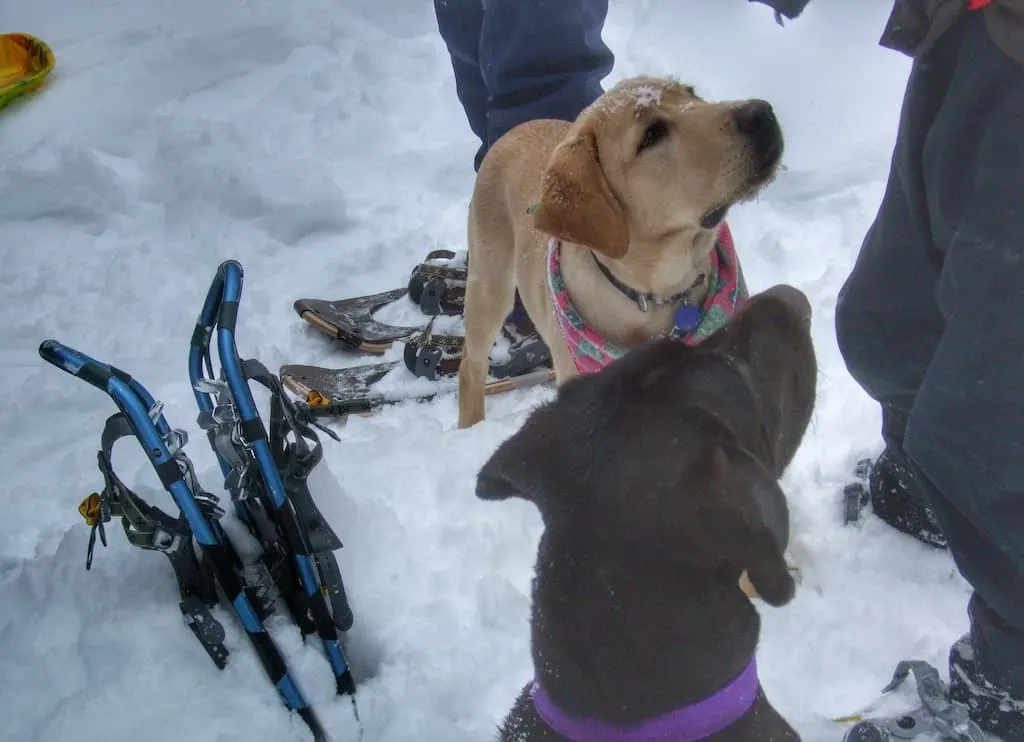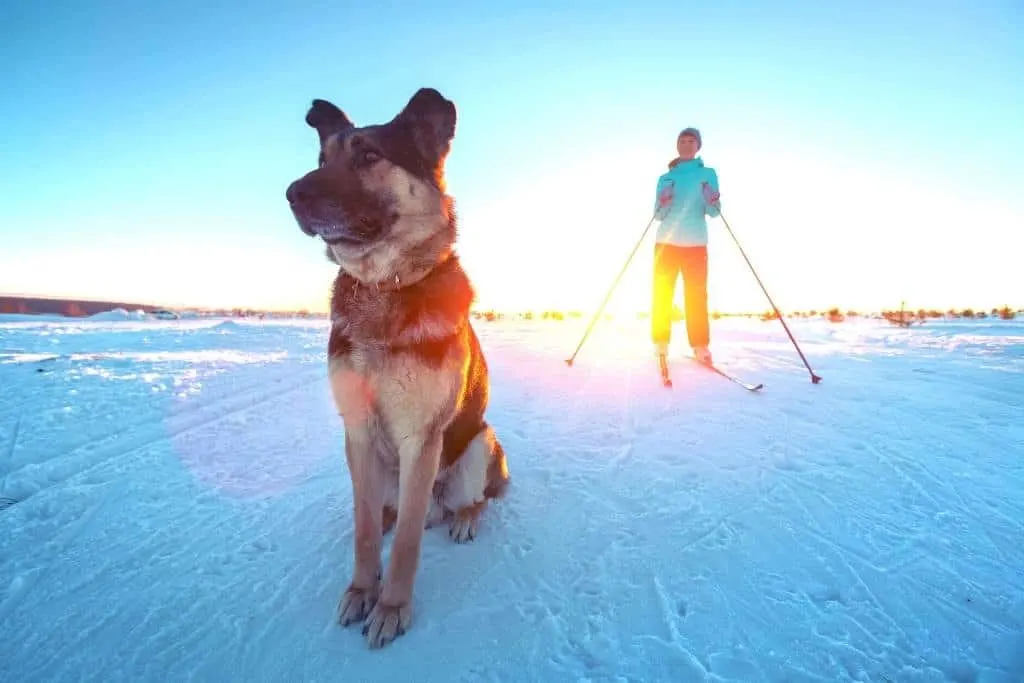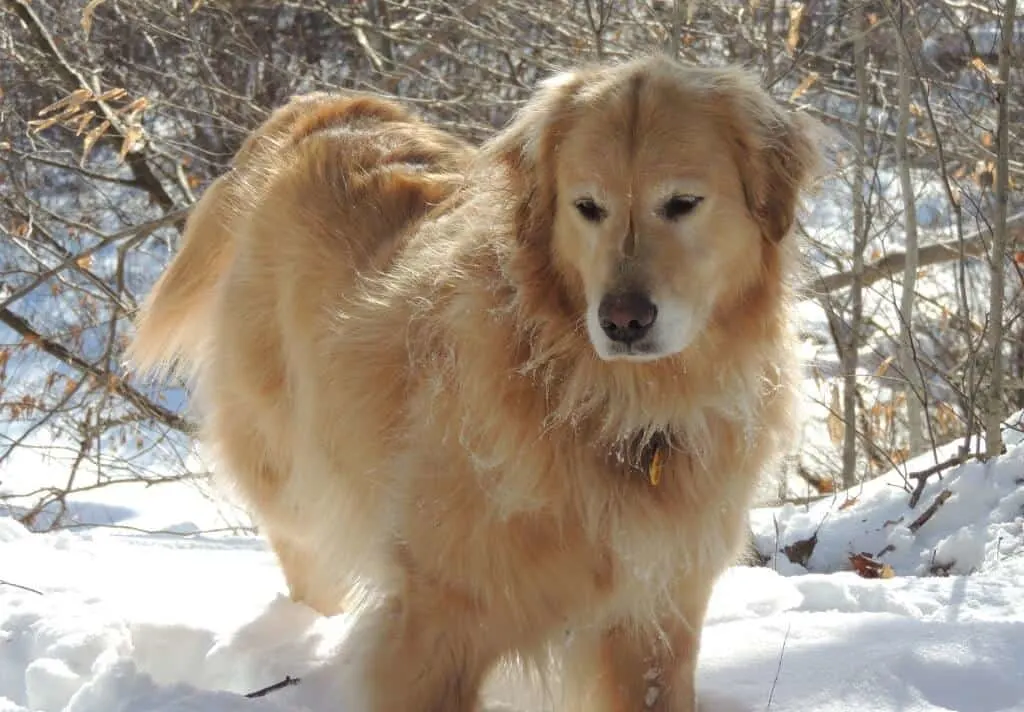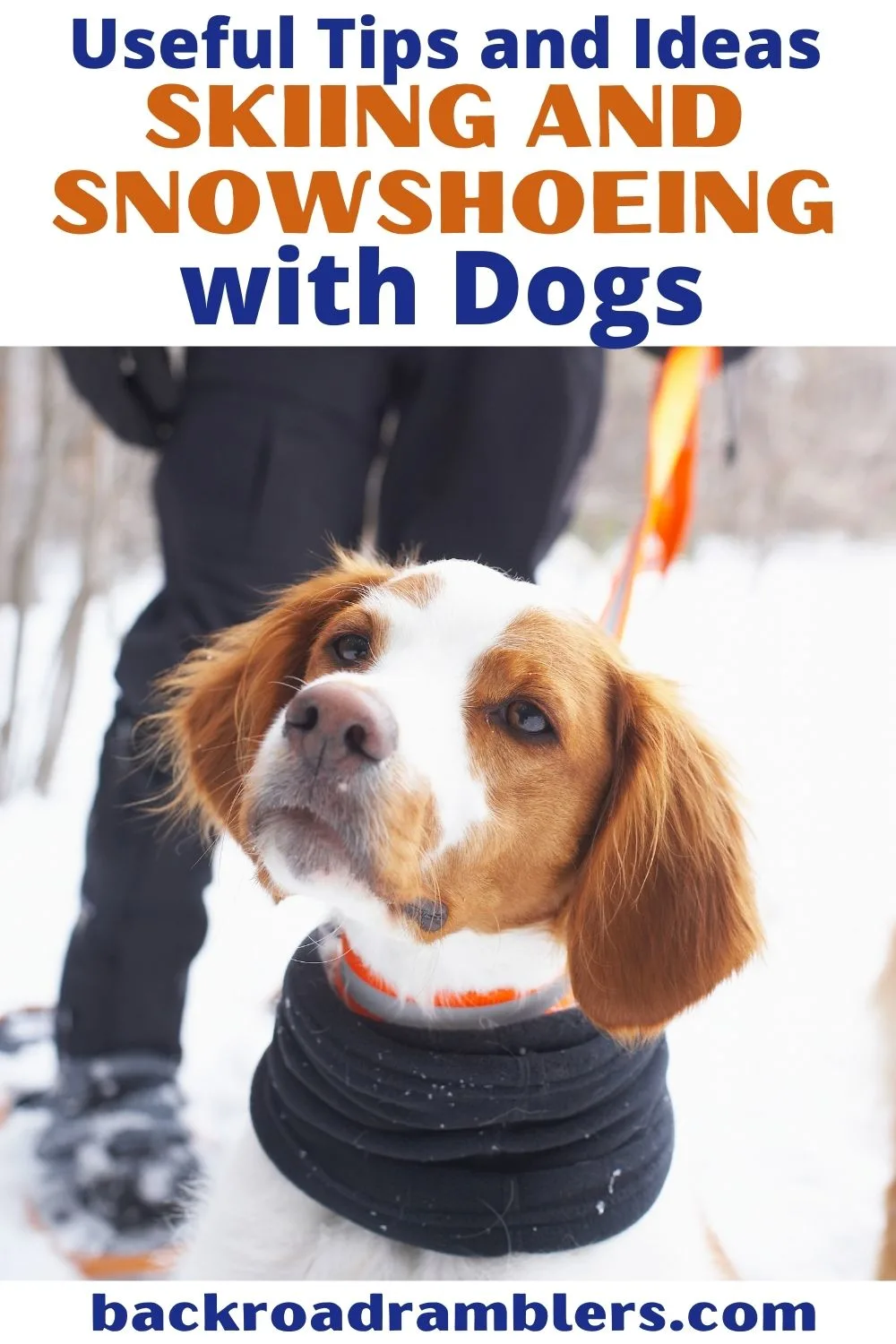If you share your life with a dog, you probably already know that winter provides many unique opportunities and challenges for adventuring together.

Most dogs, especially the young ones, don’t differentiate between beautiful sunny days and frigid snowy ones. They are up for anything, despite the weather.
And if you live in a place with snowy winters, there is no better way to enjoy winter than skiing and snowshoeing with dogs.
Dogs are an inspiration – getting us off the couch and out of our weather-induced funk.
Even on those days when you’d rather be curled up with a good book by the woodstove, your dog likely has more adventurous ideas. For better or for worse, getting outside with your dogs is great exercise for all of you.
It doesn’t take much to adventure with your dog in the winter – just a bit of willpower to get out the door and a whole lot of love for your favorite explorer.
Ready to get started with some canine-inspired outdoor adventuring? Here are some of the winter tips for skiing and snowshoeing with dogs that we’ve learned from a lifetime of adventuring together.
Table of Contents
Our Best Tips for Snowshoeing with Dogs

If you’ve ever wondered if dogs can go snowshoeing, we’re happy to say that the answer is yes!
Dogs may not be able to don their very own snowshoes, but their feet are usually well-suited to winter conditions.
Snowshoeing, with its slow pace through lovely winter landscapes, is a perfect activity to share with your dog. Provided that your pup is a decent leash walker, you will find it fairly easy to handle a leash on snowshoes, and your pup can walk behind you in your tracks if the snow gets too deep.
Snowshoeing with dogs is like the gateway drug to exploring the outdoors in the winter. It’s easy, not too expensive to get started with, and as long as you have snow, you can do it just about anywhere!
Before you get started snowshoeing with dogs, there are a few things you should think about and prepare for.
- Consider your dog’s stamina before your adventure. Walking and running through snow can be physically demanding — for you and your dog. When you are first getting started snowshoeing with dogs, take it slow, and if you notice signs of fatigue in your pup, be prepared to turn around or take a break.
Like all physical activity, snowshoeing with dogs requires conditioning. Start by tackling trails that are short and don’t require a lot of elevation gain. As you and your dog get used to the physical demands of snowshoeing, you can increase the time you spend on the trail, as well as the difficulty of the hike.
- Protect your dog from the cold. Prolonged exposure to the elements can lead to frostbite or hypothermia, even in dogs. Don’t assume that because your dog has a coat of fur, he won’t get cold.
Short-haired breeds may benefit from an extra layer, like the Ruffwear Powderhound Dog Jacket, on really cold days. Our older Labrador, Flynn, wears a coat on the coldest days and appreciates the extra warmth.

- Protect your pup’s feet from snow and ice. Dogs love powder days, but it’s more common that we’ll encounter crusty, icy conditions here in Vermont. For these conditions, we recommend sturdy boots with good traction to protect your dogs’ feet from cuts.
Although they’re pricy, we love these Ruffwear Polar Trex boots, and they stay on really well. We learned a lesson buying cheap boots season after season and consistently losing them.
I think the Polar Trex boots are the best dog boots for snow and ice, especially if the temps drop below zero. They are also really awesome for keeping your dogs’ feet protected from salty roads and sidewalks.
If I know we’re going to be out in the deep snow (and not salt and ice), we skip the boots and rely on Musher’s Secret, a wax-based ointment made in Canada that protects paws from ice build-up and snow-balling.
If your dog won’t wear boots, Musher’s Secret is the best paw protection for dogs in winter, keeping salt and ice away from their tender pads. We use Musher’s Secret on all of our dogs in the winter, but it’s especially useful for dogs with furry feet because it prevents those little ice balls from forming.
- Try a running leash when snowshoeing with your dog. If you’re using poles when snowshoeing with dogs, or just don’t want to deal with holding a leash in your mittened hands, try a hands-free leash that wraps securely around your waist.
The TUFF MUTT Hands-Free Leash is 48 inches long with a built-in bungee that extends to 60 inches – the perfect leash for snowshoeing with dogs.
My only word of caution is that you should use this with a dog who is already trained to walk nicely on a leash. Using it with an out-of-control dog is a dangerous endeavor. Practice with your running leash until you can use it confidently while snowshoeing with your dog.
The Best Snowshoes for Beginners
If you are just getting started snowshoeing with dogs, you’ll want to buy snowshoes that are easy to use, rugged, and affordable.
The type of snowshoes you buy will depend a lot on personal preference and the snow you usually hike in. Here are a few great snowshoes for beginners that work in different conditions.
- MSR Evo Snowshoes: These are my husband’s favorite snowshoes for backcountry adventuring. They are incredibly rugged, work well on uphills, and give you plenty of traction on icy trails. They’re also quite affordable. My only complaint is that they make a lot of noise in the woods, but that’s a minor issue.
- Tubbs Frontier Snowshoes for Women: These affordable snowshoes for women come in different colors and sizes and are perfect for use on packed hiking trails. They’re small and lightweight, making them a great beginner snowshoe.
- Yukon Charlie’s Sherpa Snowshoe Kit: We have had great luck with Yukon Charlie’s snowshoes, and this kit includes everything you need to get started snowshoeing with dogs, including an easy-to-use ratchet binding system, and steel crampons. The kit also comes with trekking poles and a carrying case. These snowshoes can be used in deep powder or on crusty ice.
Tips for Cross-Country Skiing with Dogs

Cross-country skiing is a fast and quiet sport, the perfect exercise to get your heart pumping and your dog panting.
When skiing with dogs, you can look for groomed trails, or you can break your own trail in the woods, fields, or parks where you live.
Skiing with dogs is a little bit trickier than snowshoeing with dogs because you are moving faster and will have less control over your pup’s actions.
If you are willing to train your dog to stay with you, but not in front of you, skiing can be a rewarding and fun activity to do with your dog.
We are not expert skiers and our dogs are not expert listeners, so we rarely visit groomed trails with our dogs. Instead, we stick to the woods near our house, where there are very few people and even fewer dogs. Here’s what we’ve learned about cross-country skiing with dogs.
- Use a leash at your own risk. Because you’re moving at a faster pace than snowshoeing, there’s more potential for injury if you’re tied to your dog. Have you heard of skijoring? It’s a winter sport where you are actually pulled by your dog(s) while you ski! We’ve never done it, but it sounds like a really fun way to get exercise!
If you aren’t ready to learn skijoring with your dog, I’d recommend training your dog to reliably come when called and to reliably stay behind you when skiing without using a leash. This is easier to practice on flat terrain with minimal distractions. Once your dog has a reliable recall and knows not to cut in front of you, you can practice on gentle slopes.
- Mind your fellow skiers. More and more Nordic ski centers are designating dog-friendly trails for people to go skiing with dogs. You’re bound to find other dog lovers on these ski trails and some other dogs too. If you aren’t on a trail specifically created for people and dogs, be mindful of the other skiers on the trail. Clean up after your dog and be sure to keep him with you at all times. If your dog does not have a solid recall, stick to backcountry trails where you won’t find many people.
Take Lots of Breaks. Running through the snow behind Nordic skis is even more demanding than walking behind snowshoes. When skiing with dogs, be sure to stop every 15 to 20 minutes, depending on your dog’s level of physical fitness. Some dogs just don’t know when to stop and will run themselves ragged before taking a break. Give your dog plenty of water and a little snack every hour or so. This silicone collapsible bowl will tuck neatly into your backpack for water breaks.

Winter Safety Tips for Dogs
Skiing and snowshoeing with dogs are our favorite ways to get out in the winter, but when the snow gods don’t bless us with lots of fluffy white, we spend time hiking and even walking and running on the roads.
Depending on the dogs we’re going out with, we make use of Musher’s Secret or the Polar Trex dog boots whenever we walk on the salty winter pavement. Here are a few more general tips for enjoying winter with your dog.
How cold is too cold for winter adventuring with dogs?

During extremely frigid temperatures, your dog’s ears, nose, and paws may be susceptible to frostbite. The amount of time a person or a dog should spend outside in cold weather is determined by the outside temperature and the wind chill factor.
The chart above will give you a good idea of how long an adult dog should spend outside in the cold.
Young pups and senior dogs should spend even less time outdoors when the temperatures drop. Here are a few additional tips for keeping your dog warm during winter adventures:
- Inspect your dog’s paws after each winter walk, especially if your dog doesn’t wear boots. Use a soft damp cloth to clean off the salt and chemicals from your dog’s paws. You don’t want him licking them when they’re covered in gunk!
- Make sure your dog drinks enough water. The drive to drink isn’t as strong in cooler temperatures, so you may have to remind your dog to stay hydrated while adventuring. Bring extra water and a collapsible bowl for water breaks.

One of the best things about dogs is that they’re ALWAYS ready for an adventure.
I think we love the outdoors as much as we do because of our dogs. They remind us that life doesn’t begin and end within the comfort of four sturdy walls! Also, I don’t think we would survive in the Northeast without the ability to get outside all through the year!
There’s an amazing world to explore out there, and it’s up to us to get out and enjoy it. How does your dog fit into your winter adventures? We’d love to hear your own tips in the comments below.
Want to read more about adventuring with dogs? Check out these posts:
- How to Road Trip with Your Dog for the Best Adventure Ever
- The Complete Guide to Paddling with Dogs
- Awesome Summer Adventures to Take with Your Dog
- Awesome Gifts for Outdoor Dogs
- The Ultimate Guide to Camping with Dogs
Connect with us on social media!


Tara is a freelance writer and travel blogger with a passion for outdoor adventures. She is the co-author of AMC’s Best Day Hikes in Vermont and currently blogs at Back Road Ramblers and Vermont Explored, where she shares travel tips, adventure destinations, and vacation ideas for the wanderer in everyone.
